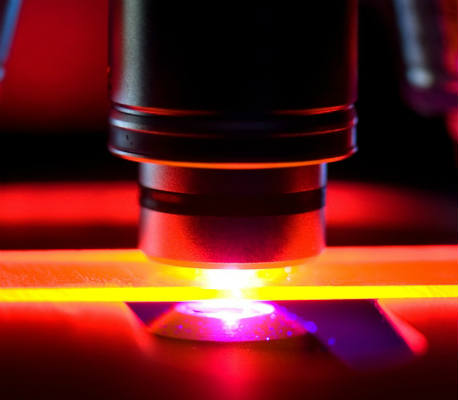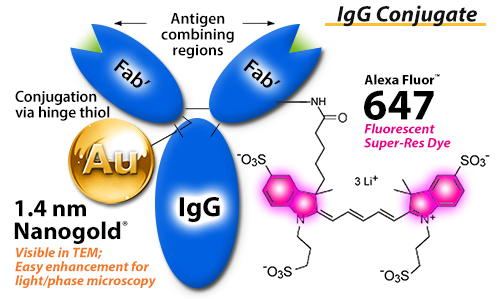39 fluorescent labels and light microscopy
Light Sheet Fluorescence Microscopy - an overview ... Applications of single-molecule fluorescence microscopy. (A) The photophysical properties of a fluorophore contain information about its position and its state. This allows, for example, tracking molecules, observing conformational and constitutional changes, or following chemical reactions. (B) Examples for applications in biology and chemistry. A quick guide to light microscopy in cell biology - PMC Fluorescence microscopy uses fluorescent dyes (fluorophores), which are molecules that absorb one wavelength of light (the excitation wavelength) and emit a second, longer wavelength of light (the emission wavelength).
Super-resolution Microscopy Takes On Third Dimension ... The primary challenge, Hess explained, was that in fluorescence microscopy, the key light waves travel from fluorescent tags within the sample itself, not from a readily manipulated laser. "It's a ...

Fluorescent labels and light microscopy
Rethinking Fluorescence Microscopy | Lab Manager One such piece of laboratory equipment is the fluorescence microscope. Although a familiar sight in many life science laboratories, the light source can easily be overlooked. Many microscopes still use energy-hungry, toxic mercury or metal halide lamps, but modern LED technology now offers a cleaner, more efficient, and high-performance ... What do researchers use fluorescent labels and light ... What do reseaches use fluorescent labels and light microscopy to do? A) produce movies of cells as they grow, divide and develop B) scan cells with laser beans C) follow molecules moving through ... Imaging Flies by Fluorescence Microscopy: Principles ... Fluorescence microscopy in combination with specific labeling methods [ e.g., antibodies or fluorescent proteins (FPs)] enables selective visualization of the components of living matter, from molecules and organelles to cells and tissues, in both fixed and living organisms, and with high signal-to-noise ratio (SNR).
Fluorescent labels and light microscopy. Fluorescent Labeling - What You Should Know - PromoCell Fluorescence microscopy allows the identification of cells and cellular components and the monitoring of cell physiology with high specificity. Fluorescence microscopy separates emitted light from excitation light using optical filters. The use of two indicators also allows the simultaneous observation of different biomolecules at the same time. A quick guide to light microscopy in cell biology FLUORESCENCE MICROSCOPY Fluorescence microscopy uses fluorescent dyes (fluorophores), which are molecules that absorb one wavelength of light (the excita - tion wavelength) and emit a second, longer wavelength of light (the emission wavelength). Most molecules in the cell are not very fluo-rescent, so fluorescent labels to be imaged are ... Novel Fluorescent Label Shines a Light on DNA Structure in ... Liu and her team formulated a new label called Hoechst-Cy5 to overcome the hurdle that fluorescent dyes didn't work well on DNA or in processed clinical cancer samples. After showing that the new... Researchers Develop New Fluorescent DNA Label for Clinical ... Superresolution fluorescence microscopy creates clearer biological images through the blinking on and off of specific labels at different times, allowing a composite image to be reconstructed showing all of the labeled components in high resolution.
Fluorescence Microscopy - New York Microscope Company Fluorescence microscopy uses a high-intensity light source that excites a fluorescent molecule called a fluorophore in the sample observed. The samples are labeled with fluorophore where they absorb the high-intensity light from the source and emit a lower energy light of longer wavelength. Label-free prediction of three-dimensional fluorescence ... Label-free prediction of three-dimensional fluorescence images from transmitted-light microscopy Understanding cells as integrated systems is central to modern biology. Although fluorescence microscopy can resolve subcellular structure in living cells, it is expensive, is slow, and can damage cells. Fluorescence Microscopy vs. Light Microscopy This means that fluorescent microscopy uses reflected rather than transmitted light. For example, a commonly used label is green fluorescent protein (GFP), which is excited with blue light and... Different Ways to Add Fluorescent Labels | Thermo Fisher ... Using fluorescence provides greater contrast compared to viewing your samples with brightfield microscopy alone. Labeling various targets with separate fluorescent colors allows you to visualize different structures or proteins within a cell in the same experiment.
Fluorescence Microscopy Sir George Stokes, a British scientist, first discovered fluorescence in 1852 when he observed that the mineral fluorite (Fig. 1, molecular formula CaF2) emitted red light when it was illuminated by ultraviolet excitation. Early investigations in the 19th century showed that many specimens (including minerals, crystals, drugs, butter, chlorophyll, and vitamins) fluoresce when irradiated with… Fluorescence Microscope: Principle, Types, Applications ... Fluorescence microscopy is a type of light microscope that works on the principle of fluorescence. A substance is said to be fluorescent when it absorbs the energy of invisible shorter wavelength radiation (such as UV light) and emits longer wavelength radiation of visible light (such as green or red light). Label-free prediction of three-dimensional fluorescence ... Fluorescence microscopy can resolve subcellular structure in living cells, but is expensive, slow, and toxic. Here, we present a label-free method for predicting 3D fluorescence directly from transmitted light images and demonstrate its use to generate multi-structure, integrated images. Fluorescence Microscopy & Cell Imaging | Research | UNM ... Fluorescence microscopy is routinely used to determine spatial and topological information about cells and tissues. Sophisticated laser scanning microscopic instrumentation, ultra sensitive digital cameras and specialized fluorescence probes make it possible to visualize cellular events in real time down to the molecular level.
Bright light, better labels | Nature Hell and his colleagues last month described 8 a fluorescent protein that can enable illumination-based super-resolution miscroscopy in extremely low light levels. Although most fluorescent...
Label-free prediction of three-dimensional fluorescence ... We present a label-free method for predicting three-dimensional fluorescence directly from transmitted-light images and demonstrate that it can be used to generate multi-structure, integrated...
Fluorescence Imaging - Teledyne Photometrics Fluorescent molecules (known as fluorophores) are used to label samples, and fluorophores are available that emit light in virtually any color. In a fluorescent microscope, a sample is labeled with a fluorophore, and then a bright light ( excitation light) is used to illuminate the sample, which gives off fluorescence ( emission light ).
In Silico Labeling: Predicting Fluorescent Labels in ... Fluorescence microscopy images can be predicted from transmitted-light z stacks • 7 fluorescent labels were validated across three labs, modalities, and cell types • New labels can be predicted using minimal additional training data Summary Microscopy is a central method in life sciences.
A quick guide to light microscopy in cell biology ... Fluorescence microscopy uses fluorescent dyes (fluorophores), which are molecules that absorb one wavelength of light (the excitation wavelength) and emit a second, longer wavelength of light (the emission wavelength). Most molecules in the cell are not very fluorescent, so fluorescent labels to be imaged are typically introduced by the ...
Fluorescent tag - Wikipedia Fluorescent labels can be hybridized to mRNA to help visualize interaction and activity, such as mRNA localization. An antisense strand labeled with the fluorescent probe is attached to a single mRNA strand, and can then be viewed during cell development to see the movement of mRNA within the cell. Fluorogenic labels
Introduction to Fluorescence Microscopy | Nikon's MicroscopyU Introduction to Fluorescence Microscopy. The absorption and subsequent re-radiation of light by organic and inorganic specimens is typically the result of well-established physical phenomena described as being either fluorescence or phosphorescence. The emission of light through the fluorescence process is nearly simultaneous with the ...
Fluorescence microscopy: established and emerging methods ... The primary concern in all forms of microscopy is the generation of contrast; for fluorescence microscopy contrast can be thought of as the difference in intensity between the cell and background, the signal-to-noise ratio. High information-content images can be formed by enhancing the signal, suppressing the noise, or both.
Light Microscope - an overview | ScienceDirect Topics Light microscopes can be adapted to examine specimens of any size, whole or sectioned, living or dead, wet or dry, hot or cold, and static or fast-moving. They offer a wide range of contrast techniques, providing information on the physical, chemical, and biological attributes of specimens. The image from a light microscope is presented in color.

Label-free prediction of three-dimensional fluorescence images from transmitted-light microscopy ...
Light Microscope- Definition, Principle, Types, Parts ... A light microscope is a biology laboratory instrument or tool, that uses visible light to detect and magnify very small objects and enlarge them. They use lenses to focus light on the specimen, magnifying it thus producing an image. The specimen is normally placed close to the microscopic lens.
Fluorescent Dyes | Science Lab | Leica Microsystems A basic principle in fluorescence microscopy is the highly specific visualization of cellular components with the help of a fluorescent agent. This can be a fluorescent protein - for example GFP - genetically linked to the protein of interest. If cloning is impossible - for instance in histologic samples - techniques such as immunofluorescence staining are used to visualize the protein ...
Imaging Flies by Fluorescence Microscopy: Principles ... Fluorescence microscopy in combination with specific labeling methods [ e.g., antibodies or fluorescent proteins (FPs)] enables selective visualization of the components of living matter, from molecules and organelles to cells and tissues, in both fixed and living organisms, and with high signal-to-noise ratio (SNR).
What do researchers use fluorescent labels and light ... What do reseaches use fluorescent labels and light microscopy to do? A) produce movies of cells as they grow, divide and develop B) scan cells with laser beans C) follow molecules moving through ...
Rethinking Fluorescence Microscopy | Lab Manager One such piece of laboratory equipment is the fluorescence microscope. Although a familiar sight in many life science laboratories, the light source can easily be overlooked. Many microscopes still use energy-hungry, toxic mercury or metal halide lamps, but modern LED technology now offers a cleaner, more efficient, and high-performance ...











Post a Comment for "39 fluorescent labels and light microscopy"